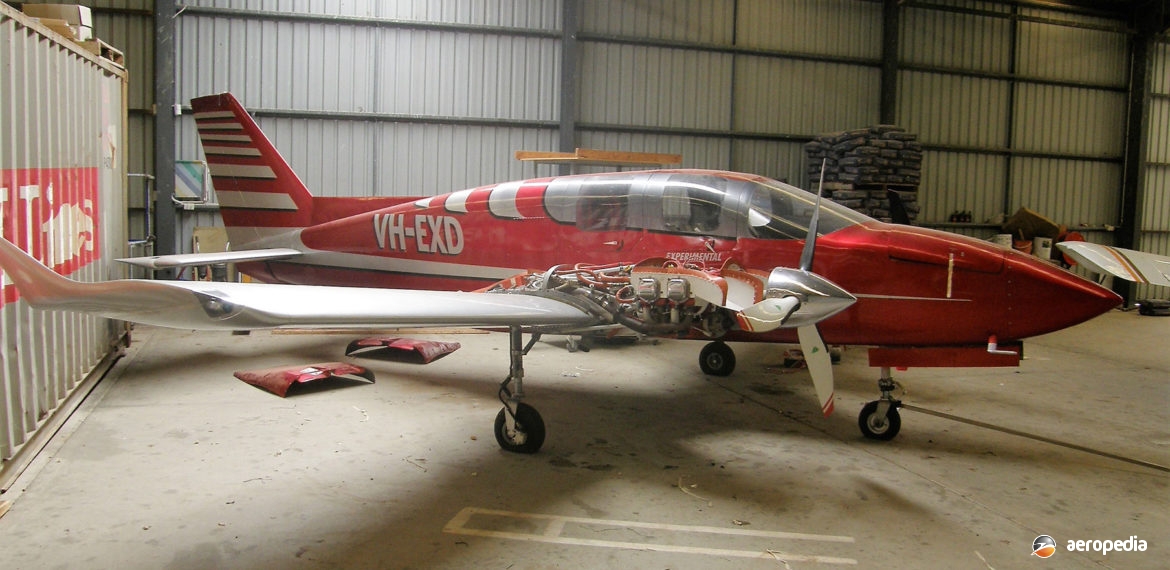Photograph:
Australia’s only Wing Derringer VH-EXD (c/n 0001) at Goolwa, SA on 17 August 2009 (Nigel Daw)
Country of origin:
United States of America
Description:
Two-seat light twin-engine sport monoplane
Power Plant:
(Prototype) Two 86 kw (115 hp) Continental IO-200 four-cylinder horizontally-opposed air-cooled engines
Specifications:
- Wingspan: 8.9 m (29 ft 2 in)
- Length: 7.01 m (23 ft)
- Height: 2.43 m (8 ft)
- Production aircraft specifications
- Cruising speed at 2,438 m (8,000 ft): 304 km/h (189 mph)
- Stalling speed full flap: 106 km/h (66 mph)
- Stalling speed no flaps: 132 km/h (82 mph)
- Rate of climb: 366 m/min (1,200 ft/min)
- Take-off run: 214 m (702 ft)
- Range: 1,609 km (1,000 miles)
- Ceiling [standard engine]: 7,010 m (23,000 ft)
- Ceiling [supercharged engine]: 9,906 m (32,500 ft)
- Baggage capacity: 0.62 m³ (22 cub ft)
- Empty weight: 444 kg (980 lb)
History:
The Derringer was designed by George Wing and built by his Company, Wing Aircraft and Hi Shear, in the early 1960s at Torrance, California as a two-seat, twin-engine sporting and training monoplane with a retractable undercarriage. The prototype (N3621G) was first flown in 1963 and was fitted with two 86 kw (115 hp) Continental IO-200 engines with fuel injection but, after some test flying, it was decided to fit two 112 kw (150 hp) Lycoming IO-320 engines driving two-blade fully feathering constant speed Hartzell propellers, with Rajay turbochargers to increase performance. Fuel was contained in two fuel tanks, one in each wing, providing a total of 400 litres (88 Imp gals). The second airframe (c/n 2) was used for static testing and the third (c/n 3) for certification.
A small production batch of aircraft was laid down. Plans were to produce the aircraft in a facility at Okmulgee near Tulsa, Oklahoma. Initial engineering work was carried out by John Thorp in 1958 with help from Harold Dale, John Thorp being the project engineer, the aircraft initially being developed as a scaled up twin-engine variant of the Thorp T-11 Sky Skooter. It was expected the turbo-charged variant would have a cruising speed at 6,096 m (20,000 ft) at 75% power of 402 km/h (250 mph). Consideration was given to fitting 186 kw (250 hp) Allison 150-139 turboprops which would have necessitated the carriage of additional fuel in wing-tip tanks.
The background of the design stems back to Wing Aircraft doing a survey of flights made by four to seven-seat aircraft. It was found that 57% of all trips only had one or two persons on board. It was thus decided to trade the weight and loss of empty seats for the dependability and performance of a compact twin. The company believed there was a market for an aircraft of this type as a second aircraft for large companies and smaller organisations, and interest was shown by flight school operators for the design as a high-performance twin with a retractable undercarriage. The number of aircraft completed is not known but some records indicate five were completed and registered in the United States, of which three were built by Transland, a Wing Aircraft subsidiary.
In later years the design remained dormant, but in about 2006 an Australian Company, Derringer X Pty Ltd of Norwood Terrace, Adelaide, SA, obtained rights to the design and on 15 March 2007 registered an example, known as the DX-1 Derringer X, as VH-EXD (c/n 0001) and announced it was commencing production of the type to meet aero-club and private owner requirements.
As at late 2019 no further examples had been registered in Australia. Ten examples of the original production batch are known to survive in the United States. The Australian prototype has been stored incomplete at Goolwa in South Australia.

